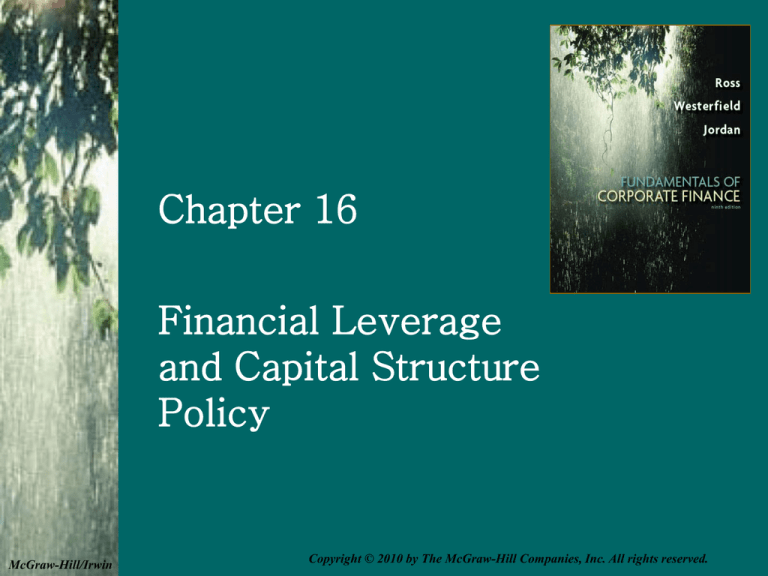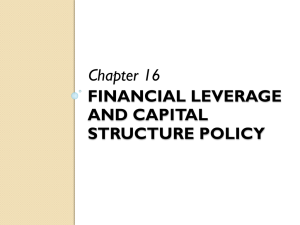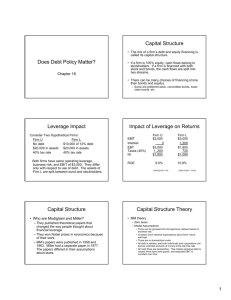
Chapter 16
Financial Leverage
and Capital Structure
Policy
McGraw-Hill/Irwin
Copyright © 2010 by The McGraw-Hill Companies, Inc. All rights reserved.
Key Concepts and Skills
• Understand the effect of financial
leverage on cash flows and the cost
of equity
• Understand the impact of taxes and
bankruptcy on capital structure
choice
• Understand the basic components of
the bankruptcy process
16-2
Chapter Outline
•
•
•
•
•
•
•
•
•
•
The Capital Structure Question
The Effect of Financial Leverage
Capital Structure and the Cost of Equity Capital
M&M Propositions I and II with Corporate Taxes
Bankruptcy Costs
Optimal Capital Structure
The Pie Again
The Pecking-Order Theory
Observed Capital Structures
A Quick Look at the Bankruptcy Process
16-3
Capital Restructuring
• We are going to look at how changes in capital
structure affect the value of the firm, all else equal
• Capital restructuring involves changing the amount
of leverage a firm has without changing the firm’s
assets
• The firm can increase leverage by issuing debt
and repurchasing outstanding shares
• The firm can decrease leverage by issuing new
shares and retiring outstanding debt
16-4
Choosing a Capital
Structure
• What is the primary goal of financial
managers?
– Maximize stockholder wealth
• We want to choose the capital structure that
will maximize stockholder wealth
• We can maximize stockholder wealth by
maximizing the value of the firm or
minimizing the WACC
16-5
The Effect of Leverage
• How does leverage affect the EPS and ROE of a
firm?
• When we increase the amount of debt financing,
we increase the fixed interest expense
• If we have a really good year, then we pay our
fixed cost and we have more left over for our
stockholders
• If we have a really bad year, we still have to pay
our fixed costs and we have less left over for our
stockholders
• Leverage amplifies the variation in both EPS and
ROE
16-6
Example: Financial Leverage,
EPS and ROE – Part I
• We will ignore the effect of taxes at this
stage
• What happens to EPS and ROE when we
issue debt and buy back shares of stock?
16-7
Example: Financial Leverage,
EPS and ROE – Part II
• Variability in ROE
– Current: ROE ranges from 6% to 20%
– Proposed: ROE ranges from 2% to 30%
• Variability in EPS
– Current: EPS ranges from $0.60 to $2.00
– Proposed: EPS ranges from $0.20 to $3.00
• The variability in both ROE and EPS
increases when financial leverage is
increased
16-8
Break-Even EBIT
• Find EBIT where EPS is the same under
both the current and proposed capital
structures
• If we expect EBIT to be greater than the
break-even point, then leverage may be
beneficial to our stockholders
• If we expect EBIT to be less than the
break-even point, then leverage is
detrimental to our stockholders
16-9
Example: Break-Even EBIT
EBIT
EBIT 250,000
500,000
250,000
500,000
EBIT 250,000
EBIT
250,000
EBIT 2EBIT 500,000
EBIT $500,000
500,000
EPS
$1.00
500,000
16-10
Example: Homemade Leverage
and ROE
• Current Capital
• Proposed Capital
Structure
Structure
• Investor borrows $500
• Investor buys $250 worth of
and uses $500 of her own
stock (25 shares) and $250
to buy 100 shares of stock
worth of bonds paying 10%.
• Payoffs:
• Payoffs:
– Recession: 100(0.60) .1(500) = $10
– Expected: 100(1.30) .1(500) = $80
– Expansion: 100(2.00) .1(500) = $150
– Recession: 25(.20) +
.1(250) = $30
– Expected: 25(1.60) +
.1(250) = $65
– Expansion: 25(3.00) +
.1(250) = $100
• Mirrors the payoffs from
• Mirrors the payoffs from
purchasing 50 shares of
purchasing 50 shares under
the firm under the
the current capital structure
proposed capital structure
16-11
Capital Structure Theory
• Modigliani and Miller (M&M)Theory of
Capital Structure
– Proposition I – firm value
– Proposition II – WACC
• The value of the firm is determined by the
cash flows to the firm and the risk of the
assets
• Changing firm value
– Change the risk of the cash flows
– Change the cash flows
16-12
Capital Structure Theory Under
Three Special Cases
• Case I – Assumptions
– No corporate or personal taxes
– No bankruptcy costs
• Case II – Assumptions
– Corporate taxes, but no personal taxes
– No bankruptcy costs
• Case III – Assumptions
– Corporate taxes, but no personal taxes
– Bankruptcy costs
16-13
Case I – Propositions I and II
• Proposition I
– The value of the firm is NOT affected by
changes in the capital structure
– The cash flows of the firm do not
change; therefore, value doesn’t
change
• Proposition II
– The WACC of the firm is NOT affected
by capital structure
16-14
Case I - Equations
• WACC = RA = (E/V)RE + (D/V)RD
• RE = RA + (RA – RD)(D/E)
– RA is the “cost” of the firm’s business risk, i.e.,
the risk of the firm’s assets
– (RA – RD)(D/E) is the “cost” of the firm’s
financial risk, i.e., the additional return required
by stockholders to compensate for the risk of
leverage
16-15
Figure 16.3
16-16
Case I - Example
• Data
– Required return on assets = 16%; cost of debt = 10%;
percent of debt = 45%
• What is the cost of equity?
– RE = 16 + (16 - 10)(.45/.55) = 20.91%
• Suppose instead that the cost of equity is 25%, what
is the debt-to-equity ratio?
– 25 = 16 + (16 - 10)(D/E)
– D/E = (25 - 16) / (16 - 10) = 1.5
• Based on this information, what is the percent of
equity in the firm?
– E/V = 1 / 2.5 = 40%
16-17
The CAPM, the SML and
Proposition II
• How does financial leverage affect systematic
risk?
• CAPM: RA = Rf + A(RM – Rf)
– Where A is the firm’s asset beta and measures the
systematic risk of the firm’s assets
• Proposition II
– Replace RA with the CAPM and assume that the debt is
riskless (RD = Rf)
– RE = Rf + A(1+D/E)(RM – Rf)
16-18
Business Risk and
Financial Risk
• RE = Rf + A(1+D/E)(RM – Rf)
• CAPM: RE = Rf + E(RM – Rf)
– E = A(1 + D/E)
• Therefore, the systematic risk of the stock
depends on:
– Systematic risk of the assets, A, (Business
risk)
– Level of leverage, D/E, (Financial risk)
16-19
Case II – Cash Flow
• Interest is tax deductible
• Therefore, when a firm adds debt, it
reduces taxes, all else equal
• The reduction in taxes increases the
cash flow of the firm
• How should an increase in cash
flows affect the value of the firm?
16-20
Case II - Example
Unlevered Firm
EBIT
Levered Firm
5,000
5,000
Interest
0
500
Taxable
Income
5,000
4,500
Taxes (34%)
1,700
1,530
Net Income
3,300
2,970
CFFA
3,300
3,470
16-21
Interest Tax Shield
• Annual interest tax shield
– Tax rate times interest payment
– 6,250 in 8% debt = 500 in interest expense
– Annual tax shield = .34(500) = 170
• Present value of annual interest tax shield
– Assume perpetual debt for simplicity
– PV = 170 / .08 = 2,125
– PV = D(RD)(TC) / RD = DTC = 6,250(.34) = 2,125
16-22
Case II – Proposition I
• The value of the firm increases by the
present value of the annual interest tax
shield
– Value of a levered firm = value of an unlevered
firm + PV of interest tax shield
– Value of equity = Value of the firm – Value of
debt
• Assuming perpetual cash flows
– VU = EBIT(1-T) / RU
– VL = VU + DTC
16-23
Example: Case II –
Proposition I
• Data
– EBIT = 25 million; Tax rate = 35%; Debt = $75
million; Cost of debt = 9%; Unlevered cost of
capital = 12%
• VU = 25(1-.35) / .12 = $135.42 million
• VL = 135.42 + 75(.35) = $161.67 million
• E = 161.67 – 75 = $86.67 million
16-24
Figure 16.4
16-25
Case II – Proposition II
• The WACC decreases as D/E increases
because of the government subsidy on
interest payments
– RA = (E/V)RE + (D/V)(RD)(1-TC)
– RE = RU + (RU – RD)(D/E)(1-TC)
• Example
– RE = 12 + (12-9)(75/86.67)(1-.35) = 13.69%
– RA = (86.67/161.67)(13.69) + (75/161.67)(9)(1.35)
RA = 10.05%
16-26
Example: Case II –
Proposition II
• Suppose that the firm changes its capital
structure so that the debt-to-equity ratio
becomes 1.
• What will happen to the cost of equity
under the new capital structure?
– RE = 12 + (12 - 9)(1)(1-.35) = 13.95%
• What will happen to the weighted average
cost of capital?
– RA = .5(13.95) + .5(9)(1-.35) = 9.9%
16-27
Figure 16.5
16-28
Case III
• Now we add bankruptcy costs
• As the D/E ratio increases, the probability of
bankruptcy increases
• This increased probability will increase the
expected bankruptcy costs
• At some point, the additional value of the interest
tax shield will be offset by the increase in expected
bankruptcy cost
• At this point, the value of the firm will start to
decrease, and the WACC will start to increase as
more debt is added
16-29
Bankruptcy Costs
• Direct costs
– Legal and administrative costs
– Ultimately cause bondholders to incur
additional losses
– Disincentive to debt financing
• Financial distress
– Significant problems in meeting debt
obligations
– Firms that experience financial distress do not
necessarily file for bankruptcy
16-30
More Bankruptcy Costs
• Indirect bankruptcy costs
– Larger than direct costs, but more difficult to measure
and estimate
– Stockholders want to avoid a formal bankruptcy filing
– Bondholders want to keep existing assets intact so they
can at least receive that money
– Assets lose value as management spends time worrying
about avoiding bankruptcy instead of running the
business
– The firm may also lose sales, experience interrupted
operations and lose valuable employees
16-31
Figure 16.6
16-32
Figure 16.7
16-33
Conclusions
• Case I – no taxes or bankruptcy costs
– No optimal capital structure
• Case II – corporate taxes but no bankruptcy costs
– Optimal capital structure is almost 100% debt
– Each additional dollar of debt increases the cash
flow of the firm
• Case III – corporate taxes and bankruptcy costs
– Optimal capital structure is part debt and part
equity
– Occurs where the benefit from an additional dollar
of debt is just offset by the increase in expected
bankruptcy costs
16-34
Figure 17.8
16-35
Managerial
Recommendations
• The tax benefit is only important if the firm
has a large tax liability
• Risk of financial distress
– The greater the risk of financial distress, the
less debt will be optimal for the firm
– The cost of financial distress varies across
firms and industries, and as a manager you
need to understand the cost for your industry
16-36
Figure 16.9
16-37
The Value of the Firm
• Value of the firm = marketed claims +
nonmarketed claims
– Marketed claims are the claims of stockholders and
bondholders
– Nonmarketed claims are the claims of the government
and other potential stakeholders
• The overall value of the firm is unaffected by
changes in capital structure
• The division of value between marketed claims
and nonmarketed claims may be impacted by
capital structure decisions
16-38
The Pecking-Order Theory
• Theory stating that firms prefer to issue
debt rather than equity if internal financing
is insufficient.
– Rule 1
• Use internal financing first
– Rule 2
• Issue debt next, new equity last
• The pecking-order theory is at odds with
the tradeoff theory:
– There is no target D/E ratio
– Profitable firms use less debt
– Companies like financial slack
16-39
Observed Capital Structure
• Capital structure does differ by industry
• Differences according to Cost of Capital
2008 Yearbook by Ibbotson Associates,
Inc.
– Lowest levels of debt
• Computers with 5.61% debt
• Drugs with 7.25% debt
– Highest levels of debt
• Cable television with 162.03% debt
• Airlines with 129.40% debt
16-40
Work the Web Example
• You can find information about a
company’s capital structure relative
to its industry, sector and the S&P
500 at Reuters
• Click on the web surfer to go to the
site
– Choose a company and get a quote
– Choose Ratio Comparisons
16-41
Bankruptcy Process – Part I
• Business failure – business has
terminated with a loss to creditors
• Legal bankruptcy – petition federal
court for bankruptcy
• Technical insolvency – firm is unable
to meet debt obligations
• Accounting insolvency – book value
of equity is negative
16-42
Bankruptcy Process – Part II
• Liquidation
– Chapter 7 of the Federal Bankruptcy Reform
Act of 1978
– Trustee takes over assets, sells them and
distributes the proceeds according to the
absolute priority rule
• Reorganization
– Chapter 11 of the Federal Bankruptcy Reform
Act of 1978
– Restructure the corporation with a provision to
repay creditors
16-43
Quick Quiz
• Explain the effect of leverage on EPS and ROE
• What is the break-even EBIT, and how do we
compute it?
• How do we determine the optimal capital
structure?
• What is the optimal capital structure in the three
cases that were discussed in this chapter?
• What is the difference between liquidation and
reorganization?
16-44
Ethics Issues
• Suppose managers of a firm know that the
company is approaching financial distress.
– Should the managers borrow from creditors and issue a
large one-time dividend to shareholders?
– How might creditors control this potential transfer of
wealth?
16-45
Comprehensive Problem
• Assuming perpetual cash flows in
Case II - Proposition I, what is the
value of the equity for a firm with
EBIT = $50 million, Tax rate = 40%,
Debt = $100 million, cost of debt =
9%, and unlevered cost of capital =
12%?
16-46
End of Chapter
16-47







